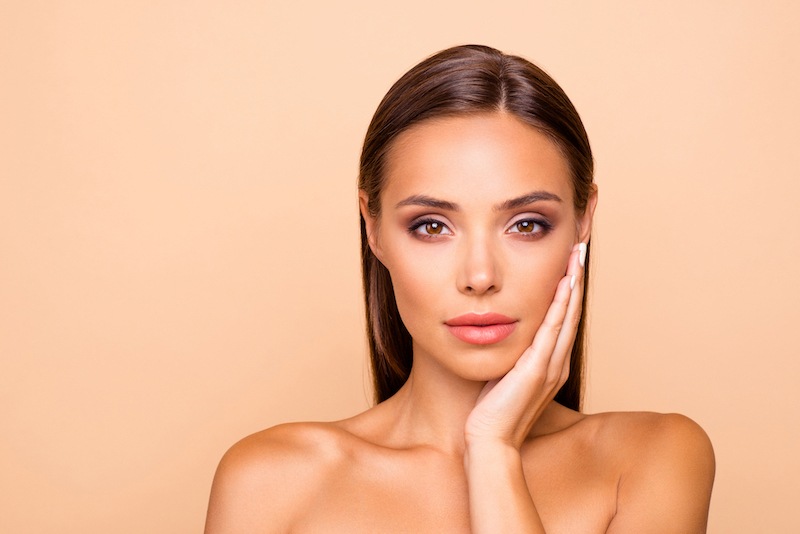Sure, we all know about Botox—it’s a household name, after all. But it’s not the only injectable on the scene. “Injectables are very popular because they address something that nearly everyone suffers from with age: Volume loss,” says Omar A. Ibrahimi, MD, PhD, medical director of Connecticut Skin Institute in Stamford, CT, who is board-certified and fellowship trained in cosmetic dermatology.
The term ‘injectables’ encompasses not only toxins, like Botox, but also fat-melting injectables, like Kybella, which can slim down the places where you’ve gained unwanted volume, and fillers. In recent years, a slew of new fillers have come out, like Juvéderm Volbella XC and Restylane Refyne, says Dr. Ibrahimi. “These are derivatives of the mainstay fillers Juvéderm and Restylane, but have slightly different chemical features, such as cross-linking or firmness to the product that might make one better to place in the lips versus using another to try to provide lift to the cheek,” he explains.
Here, we take a look at a few injectables that are trending these days—and what you need to know about them. (But first, as with any treatment, be sure to speak to a doctor about side effects, possible complications and understanding his or her experience as an injector.)
Juvéderm Volbella XC: At Greenwich Medical Spa, which has locations in Greenwich and Westport, CT and Scarsdale, NY, lip fillers are fast becoming a popular choice—thanks in large part to social media and celebs like Kylie Jenner. And Volbella is one of the products they might use. Approved by the FDA in 2016, Juvéderm Volbella is a hyaluronic acid filler, which means it’s based on substances naturally made by our skin. “Hyaluronic acid fillers tend to take very well and the risk of the skin rejecting it or not reacting well to it is very low,” says Dr. Ibrahimi. Used in the lips, it offers up a more natural look. “It’s a very nice, soft, smooth silky filler that will basically diminish the lip lines and give you a subtle plump,” explains Shilpa Desai, PA in aesthetic medicine at Greenwich Medical Spa. Results can last up to a year. Side effects can include swelling, tenderness or bruising. (There are similar, non-Juvéderm options available in the Restylane family—ask your practitioner for more info.)
Juvéderm Vollure XC: Approved for use by the FDA in the spring of 2017, this hyaluronic acid filler is ideal for people who have “more severe or deeper folds,” says Dr. Ibrahimi—so that might be the smile or marionette lines, or even the cheeks. Results can last anywhere from 12 to 18 months, he says, with similar side effects to other fillers, like swelling and bruising.
Juvéderm Voluma XC: For the cheek area, there’s Voluma, another hyaluronic acid filler, which is “used to correct volume loss in the mid-face,” says Hanna Kim, MD, a dermatologist with Connecticut Dermatology Group, which has offices in Norwalk, Milford, Stamford, and Greenwich, CT. “By replacing that volume into the mid-face, you have a more restored appearance,” she explains. The treatment can last a bit longer than others—as long as two years—and side effects are the same as the standard for fillers, including swelling and bruising. Another spot that Voluma might help: on the hands, also as a way to add volume, says Desai.
Kybella: If a double chin is getting you down, you may want to consider Kybella. “It’s injected into the fat tissue underneath the chin and helps to reduce that fat pocket,” explains Dr. Kim. Kybella, or deoxycholic acid, destroys fat cells and can give you an “improved chin profile,” says Dr. Kim. And it has lasting results: “Fat reduction is permanent,” she explains. The treatment requires multiple sessions, usually about 3 to 6, with visits made about once a month. Once done, expect to see swelling in the area, which can be significant and last for about a week or two, she explains.
Belotero Balance: Though commonly used to treat fine lines around the mouth, this hyaluronic acid filler can also be used under the eyes. “Belotero is a great filler for putting under the eyes to soften the tear trough—and lasts about a year,” explains Dr. Ibrahimi. Side effects, like swelling and bruising, can happen. Another possibility is to use it for acne scars, he says.
Sculptra Aesthetic: Sculptra, a poly-L-lactic acid, works to “help stimulate your skin’s natural collagen production,” explains Desai. “Over time, it creates a more youthful appearance by creating more volume and lift,” she adds. Don’t expect to see an immediate difference: “Because the body is turning on the collagen-making process, the results take 6 to 9 months to fully manifest,” explains Dr. Ibrahimi. Though results can last for at least two years, he says they’ll keep for even longer than that. “I love Sculptra because it allows me to help rejuvenate and refill my patients in a very subtle, slow and natural fashion,” he says.
“Injectables are very popular because they address something that nearly everyone suffers from with age: Volume loss.”
– DR OMAR A. IBRAHIMI





